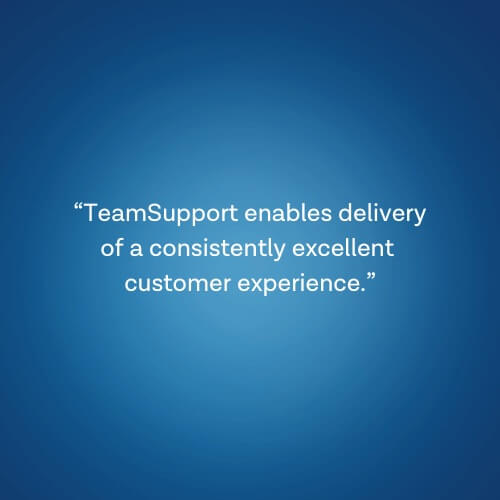
A leading global financial services software and technology company had been using TeamSupport customer support software in one of their business units for over 5 years. The customer service team was already doing an impressive job, but in 2014 one of their UK-based Senior Managers was inspired by an article from TeamSupport that detailed the benefits of moving away from tiered support and focusing on a collaborative customer support model. He envisioned a new approach that would more tightly integrate the business and service units, better support the company’s global operations, and standardize service delivery for a superior customer experience.
After evaluating existing processes, levels of business unit coordination, and the technology tools that underpinned customer support, he developed a plan. The new program was designed to enable people to do their jobs more efficiently and effectively, improve collaboration, and optimize operations on an ongoing basis.
The program was more than just a software roll-out; it was a new vision for delivering customer service, a program that provides in-depth product and industry education – similar to the training sales and product experts receive – to a new team of customer service analysts. As a result, those analysts can handle more complex issues and reduce the burden on other departments. The ability to collaborate, access institutional knowledge, and manage customer relationships is key to the program’s success.
The implementation team envisioned a wider role for TeamSupport, and tied both the program and software roll-out to a full process overhaul that made use of the support system’s various features and functionality for customer management. With TeamSupport, the company benefitted from:
- Increased collaboration and engagement
- Decrease in time for training
- Accessing valuable data and customer metrics
The Solution
One of the areas identified for improvement was effective use of resources. Instead of using high-value people in various departments for Level 1 support, the company set up a centralized support unit so product experts could once again focus on their products. They launched the program’s customer service analyst team at one of their US locations under the supervision of the Client Services Manager for that division.
The company was already using TeamSupport’s industry-leading customer service software solution, which had enabled them to optimize ticket handling and identify training needs. The new program further leverages TeamSupport to train Level 1, 2, and 3 experts. With the wider TeamSupport roll-out, they centralized training, standardized technology use, and took hiring off the business units’ plates. The company’s president had also requested deployment of a standard customer portal across the organization, and TeamSupport’s customer support solution provides that as well.
Several major global customers, including well-known banks, immediately expressed appreciation for the 24/7 on-demand access to knowledge and help via the portal on TeamSupport’s platform.
In addition to providing a ticketing solution that enables the comprehensive capture of important data, TeamSupport now provides access to a centralized knowledge base that is used for analyst training, handles all email requests, and enables broader collaboration across teams as analysts increasingly take on more challenging support requests.
The team depends heavily on TeamSupport’s integration with ServiceNow, their internal help desk system, and stresses the importance of using a proper customer support system with native capabilities, rather than patching together “add-ons” like some other support software offerings. When asked what makes TeamSupport different, the customer promptly responded “customer engagement”.
“In 2014, the program’s goal was employee enablement, and TeamSupport was part of the plan from day one,” observes the company’s Senior Program Manager. “We initialized the program in 2015, and TeamSupport technology has been essential as we globalize, improve collaboration, and proactively deliver a great customer experience. Going forward, our goal is to continuously optimize the customer experience, integrating other TeamSupport functionality to generate additional metrics, including predictive data.”
The Results
The program has already produced dozens of customer service analysts who apply their enhanced expertise and skills to deliver direct value and engage customers. The program’s more focused training approach, using TeamSupport for self-directed learning, has caused a dramatic drop in the amount of assistance business teams require from the service group to resolve customer issues, down over 70%.
The program’s more collaborative and engaged customer service analysts are also in a better position to manage customer relationships and work with colleagues worldwide, and TeamSupport’s customer support solution is being used to support a wider range of activities, with further expansion planned. The program is also opening new opportunities for participants — and savings for the company.
Where training a new hire previously took 18 months, the new program cuts that time in half, now taking only 8 or 9 months to get a new analyst actively handling support requests. The program has also taken a load off of the individual business units who no longer have to spend as much time on recruiting & training.
“The program enables delivery of a consistently excellent customer experience, but it also creates a professional services pipeline that will result in massive recruiting and training savings for us,” says the Client Services Manager. “With a fresh program vision backed up by a comprehensive B2B customer support, collaboration, and knowledge-sharing solution from TeamSupport, we’ve created a new level of internal expertise.”